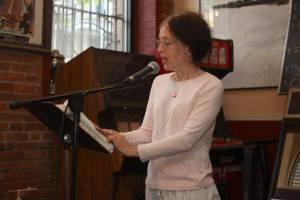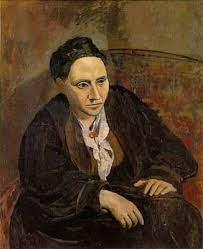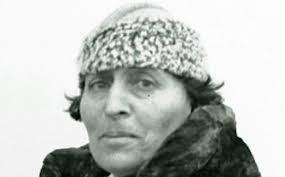
Therese performing poetry
My poet wife Therese Broderick started a Meetup group to discuss poets and poetry. Every month she’d sally forth to the appointed venue, and upon returning I’d ask her how many showed up. “One,” she’d cheerily reply. Meaning herself.
But, undaunted, she gamely kept at it, and by and by, others did begin to come; and now it’s a nice little thing.
One fellow proposed as a topic Gertrude Stein. Therese obligingly scheduled it; the fellow didn’t attend; but I did.

Picasso’s portrait of Gertrude Stein
Gertrude Stein (1874-1946) was an American writer, but spent most of her life in Paris and is actually remembered less for her writing than for all the artists and writers who hung out with her; she was the eye of an aesthetic hurricane.
The discussion about her inspired me to read The Autobiography of Alice B. Toklas. Toklas (1877-1967) was Stein’s longtime companion and (apparently?) lover. Now this is a somewhat peculiar “autobiography.” It tells very little about Toklas, but a great deal about Gertrude Stein (always called, in full, “Gertrude Stein”), and her relationships with all those belle artes luminaries. It’s immensely flattering to Gertrude Stein. At the start, Alice says “only three times in my life have I met a genius and each time a bell within me rang and I was not mistaken.” Of course one was Gertrude Stein.
And seemingly Toklas had a grandiose idea not just of Gertrude Stein’s merits but of her literary importance. We find statements like this, concerning one Gertrude Stein publication: “So for the first time a piece of the monumental work which was the beginning, really the beginning of modern writing, was printed . . . .”

Toklas
Perhaps the author really imagined that writers thenceforward would write like Gertrude Stein. I must say I’m glad they don’t. She was an innovator, and I suppose someone needed to do what she did. Her poems (if they be poems, often a matter for debate) are at least not just strings of random words, they do have some structure (e.g., the definite article before nouns), but while “word play” is not exactly it, she does play with the structure of language. Reading these poems suggested Gertrude Stein was trying to do with words just what modernist painters do with shapes and colors. Her prose often eschews commas and goes like conversational speech does, in really the most literal way, which might be fine when spoken but is affectation on the page.
The book ends with Gertrude Stein refusing to write her own autobiography, but encouraging Alice to write one. However Alice, having so much else to do, can’t get down to it. So finally, “Gertrude Stein said, it does not look to me as if you were ever going to write that autobiography. You know what I am going to do. I am going to write it for you . . . . And she has, and this is it.”
